A Comprehensive Analysis of Transcriptomics and Metabolomics Reveals Key Genes Involved in Terpenes Biosynthesis Pathway of Litsea cubeba Under Light and Darkness Treatments
Abstract
1. Introduction
2. Results
2.1. Darkness Treatment Resulted in a Significant Decrease in Monoterpenoid Content in L. cubeba Fruits
2.2. Quality Analysis of Transcriptome Sequencing Data Under Light and Darkness Treatments
2.3. Sequencing and Assembly
2.4. Analysis of DEGs
2.5. Functional Analysis of DEGs
2.6. The Expression Profile of Genes in the Terpenoid Biosynthetic Pathway in Under Light and Darkness Treatments
2.7. Validation of Some Important DEGs Profiling Using RT-qPCR
3. Discussion
4. Materials and Methods
4.1. Light and Darkness Treatments of L. cubeba Fruits
4.2. Volatile Component Analysis
4.3. RNA Extraction and cDNA Library Construction
4.4. Transcriptome Sequencing
4.5. Gene Annotation Analysis
4.6. Weighted Gene Coexpression Network Analysis
4.7. The Expression Profile of Genes Involved in the Terpene Biosynthetic Pathway
4.8. qRT-PCR Validation of Differentially Expressed Genes
4.9. Statistical Analysis
5. Conclusions
Supplementary Materials
Author Contributions
Funding
Institutional Review Board Statement
Informed Consent Statement
Data Availability Statement
Conflicts of Interest
References
- Li, C.; Zha, W.; Li, W.; Wang, J.; You, A. Advances in the Biosynthesis of Terpenoids and Their Ecological Functions in Plant Resistance. Int. J. Mol. Sci. 2023, 24, 11561. [Google Scholar] [CrossRef] [PubMed]
- Chen, F.; Tholl, D.; Bohlmann, J.; Pichersky, E. The Family of Terpene Synthases in Plants: A Mid-Size Family of Genes for Specialized Metabolism That Is Highly Diversified throughout the Kingdom. Plant J. 2011, 66, 212–229. [Google Scholar] [CrossRef]
- Tholl, D.; Lee, S. Terpene Specialized Metabolism in Arabidopsis Thaliana. Arab. Book 2011, 9, e0143. [Google Scholar] [CrossRef]
- Christianson, D.W. Structural and Chemical Biology of Terpenoid Cyclases. Chem. Rev. 2017, 117, 11570–11648. [Google Scholar] [CrossRef] [PubMed]
- Pichersky, E.; Raguso, R.A. Why Do Plants Produce so Many Terpenoid Compounds? New Phytol. 2018, 220, 692–702. [Google Scholar] [CrossRef]
- Zhang, Y.; Lin, L.; Long, Y.; Guo, H.; Wang, Z.; Cui, M.; Huang, J.; Xing, Z. Comprehensive Transcriptome Analysis Revealed the Effects of the Light Quality, Light Intensity, and Photoperiod on Phlorizin Accumulation in Lithocarpus polystachyus Rehd. Forests 2019, 10, 995. [Google Scholar] [CrossRef]
- Karimkhani, M.M.; Nasrollahzadeh, M.; Maham, M.; Jamshidi, A.; Kharazmi, M.S.; Dehnad, D.; Jafari, S.M. Extraction and Purification of α-Pinene; a Comprehensive Review. Crit. Rev. Food Sci. Nutr. 2024, 64, 4286–4311. [Google Scholar] [CrossRef]
- Jennewein, S.; Long, R.M.; Williams, R.M.; Croteau, R. Cytochrome P450 Taxadiene 5α-Hydroxylase, a Mechanistically Unusual Monooxygenase Catalyzing the First Oxygenation Step of Taxol Biosynthesis. Chem. Biol. 2004, 11, 379–387. [Google Scholar] [CrossRef]
- Teoh, K.H.; Polichuk, D.R.; Reed, D.W.; Nowak, G.; Covello, P.S. Artemisia annua L. (Asteraceae) Trichome-specific cDNAs Reveal CYP71AV1, a Cytochrome P450 with a Key Role in the Biosynthesis of the Antimalarial Sesquiterpene Lactone Artemisinin. FEBS Lett. 2006, 580, 1411–1416. [Google Scholar] [CrossRef]
- Kim, J.-H. Pharmacological and Medical Applications of Panax Ginseng and Ginsenosides: A Review for Use in Cardiovascular Diseases. J. Ginseng Res. 2018, 42, 264–269. [Google Scholar] [CrossRef]
- Chen, Y.-C.; Li, Z.; Zhao, Y.-X.; Gao, M.; Wang, J.-Y.; Liu, K.-W.; Wang, X.; Wu, L.-W.; Jiao, Y.-L.; Xu, Z.-L.; et al. The Litsea Genome and the Evolution of the Laurel Family. Nat. Commun. 2020, 11, 1675. [Google Scholar] [CrossRef] [PubMed]
- Zhao, Y.; Wang, M.; Chen, Y.; Gao, M.; Wu, L.; Wang, Y. LcERF134 Increases the Production of Monoterpenes by Activating the Terpene Biosynthesis Pathway in Litsea cubeba. Int. J. Biol. Macromol. 2023, 232, 123378. [Google Scholar] [CrossRef]
- Susila, H.; Jin, S.; Ahn, J.H. Light Intensity and Floral Transition: Chloroplast Says “Time to Flower!”. Mol. Plant 2016, 9, 1551–1553. [Google Scholar] [CrossRef]
- Feng, F.; Mei, H.; Fan, P.; Li, Y.; Xu, X.; Wei, H.; Yan, M.; Luo, L. Dynamic Transcriptome and Phytohormone Profiling along the Time of Light Exposure in the Mesocotyl of Rice Seedling. Sci. Rep. 2017, 7, 11961. [Google Scholar] [CrossRef]
- Lee, H.-J.; Park, Y.-J.; Ha, J.-H.; Baldwin, I.T.; Park, C.-M. Multiple Routes of Light Signaling during Root Photomorphogenesis. Trends Plant Sci. 2017, 22, 803–812. [Google Scholar] [CrossRef]
- Kalaitzoglou, P.; van Ieperen, W.; Harbinson, J.; van der Meer, M.; Martinakos, S.; Weerheim, K.; Nicole, C.C.S.; Marcelis, L.F.M. Effects of Continuous or End-of-Day Far-Red Light on Tomato Plant Growth, Morphology, Light Absorption, and Fruit Production. Front. Plant Sci. 2019, 10, 322. [Google Scholar] [CrossRef]
- Bergman, M.E.; Kortbeek, R.W.J.; Gutensohn, M.; Dudareva, N. Plant Terpenoid Biosynthetic Network and Its Multiple Layers of Regulation. Prog. Lipid Res. 2024, 95, 101287. [Google Scholar] [CrossRef] [PubMed]
- McGarvey, D.J.; Croteau, R. Terpenoid Metabolism. Plant Cell 1995, 7, 1015–1026. [Google Scholar] [CrossRef]
- Zhou, F.; Pichersky, E. The Complete Functional Characterisation of the Terpene Synthase Family in Tomato. New Phytol. 2020, 226, 1341–1360. [Google Scholar] [CrossRef]
- Rodríguez-Concepción, M.; Boronat, A. Breaking New Ground in the Regulation of the Early Steps of Plant Isoprenoid Biosynthesis. Curr. Opin. Plant Biol. 2015, 25, 17–22. [Google Scholar] [CrossRef]
- Ramakrishna, A.; Ravishankar, G.A. Influence of Abiotic Stress Signals on Secondary Metabolites in Plants. Plant Signal Behav. 2011, 6, 1720–1731. [Google Scholar] [CrossRef]
- Franklin, K.A. Shade Avoidance. New Phytol. 2008, 179, 930–944. [Google Scholar] [CrossRef]
- Wang, F.; Zhang, L.; Chen, X.; Wu, X.; Xiang, X.; Zhou, J.; Xia, X.; Shi, K.; Yu, J.; Foyer, C.H.; et al. SlHY5 Integrates Temperature, Light, and Hormone Signaling to Balance Plant Growth and Cold Tolerance. Plant Physiol. 2019, 179, 749–760. [Google Scholar] [CrossRef] [PubMed]
- Hao, X.; Zhong, Y.; Fu, X.; Lv, Z.; Shen, Q.; Yan, T.; Shi, P.; Ma, Y.; Chen, M.; Lv, X.; et al. Transcriptome Analysis of Genes Associated with the Artemisinin Biosynthesis by Jasmonic Acid Treatment under the Light in Artemisia Annua. Front. Plant Sci. 2017, 8, 971. [Google Scholar] [CrossRef] [PubMed]
- Jiang, M.; Ren, L.; Lian, H.; Liu, Y.; Chen, H. Novel Insight into the Mechanism Underlying Light-Controlled Anthocyanin Accumulation in Eggplant (Solanum melongena L.). Plant Sci. 2016, 249, 46–58. [Google Scholar] [CrossRef] [PubMed]
- Ni, J.; Dong, L.; Jiang, Z.; Yang, X.; Chen, Z.; Wu, Y.; Xu, M. Comprehensive Transcriptome Analysis and Flavonoid Profiling of Ginkgo Leaves Reveals Flavonoid Content Alterations in Day-Night Cycles. PLoS ONE 2018, 13, e0193897. [Google Scholar] [CrossRef]
- Yu, X.; Qi, X.; Li, S.; Fang, H.; Bai, Y.; Li, L.; Liu, D.; Chen, Z.; Li, W.; Liang, C. Transcriptome Analysis of Light-Regulated Monoterpenes Biosynthesis in Leaves of Mentha canadensis L. Plants 2021, 10, 930. [Google Scholar] [CrossRef]
- Schuster, S.C. Next-Generation Sequencing Transforms Today’s Biology. Nat. Methods 2008, 5, 16–18. [Google Scholar] [CrossRef]
- Ansorge, W.J. Next-Generation DNA Sequencing Techniques. N. Biotechnol. 2009, 25, 195–203. [Google Scholar] [CrossRef]
- Ma, X.; Meng, Y.; Wang, P.; Tang, Z.; Wang, H.; Xie, T. Bioinformatics-Assisted, Integrated Omics Studies on Medicinal Plants. Brief. Bioinform. 2020, 21, 1857–1874. [Google Scholar] [CrossRef]
- Nan, X.; Li, W.; Shao, M.; Cui, Z.; Wang, H.; Huo, J.; Chen, L.; Chen, B.; Ma, Z. Shading Treatment Reduces Grape Sugar Content by Suppressing Photosynthesis-Antenna Protein Pathway Gene Expression in Grape Berries. Int. J. Mol. Sci. 2024, 25, 5029. [Google Scholar] [CrossRef] [PubMed]
- Zhen, X.; Liu, C.; Guo, Y.; Yu, Z.; Han, Y.; Zhang, B.; Liang, Y. Leaf Senescence Regulation Mechanism Based on Comparative Transcriptome Analysis in Foxtail Millet. Int. J. Mol. Sci. 2024, 25, 3905. [Google Scholar] [CrossRef] [PubMed]
- Deng, J.; Zhang, L.; Wang, L.; Zhao, J.; Yang, C.; Li, H.; Huang, J.; Shi, T.; Zhu, L.; Damaris, R.N.; et al. The Complex FtBBX22 and FtHY5 Positively Regulates Light-Induced Anthocyanin Accumulation by Activating FtMYB42 in Tartary Buckwheat Sprouts. Int. J. Mol. Sci. 2024, 25, 8376. [Google Scholar] [CrossRef]
- Hu, Z.-H.; Sun, M.-Z.; Yang, K.-X.; Zhang, N.; Chen, C.; Xiong, J.-W.; Yang, N.; Chen, Y.; Liu, H.; Li, X.-H.; et al. High-Throughput Transcriptomic Analysis of Circadian Rhythm of Chlorophyll Metabolism under Different Photoperiods in Tea Plants. Int. J. Mol. Sci. 2024, 25, 9270. [Google Scholar] [CrossRef] [PubMed]
- Si, L.; Chen, Y.; Han, X.; Zhan, Z.; Tian, S.; Cui, Q.; Wang, Y. Chemical Composition of Essential Oils of Litsea Cubeba Harvested from Its Distribution Areas in China. Molecules 2012, 17, 7057–7066. [Google Scholar] [CrossRef]
- Chen, C.-J.; Tseng, Y.-H.; Chu, F.-H.; Wen, T.-Y.; Cheng, W.-W.; Chen, Y.-T.; Tsao, N.-W.; Wang, S.-Y. Neuropharmacological Activities of Fruit Essential Oil from Litsea cubeba Persoon. J. Wood Sci. 2012, 58, 538–543. [Google Scholar] [CrossRef]
- Gao, M.; Lin, L.; Chen, Y.; Wang, Y. Digital Gene Expression Profiling to Explore Differentially Expressed Genes Associated with Terpenoid Biosynthesis during Fruit Development in Litsea cubeba. Molecules 2016, 21, 1251. [Google Scholar] [CrossRef]
- Kamle, M.; Mahato, D.K.; Lee, K.E.; Bajpai, V.K.; Gajurel, P.R.; Gu, K.S.; Kumar, P. Ethnopharmacological Properties and Medicinal Uses of Litsea cubeba. Plants 2019, 8, 150. [Google Scholar] [CrossRef]
- Zhao, Y.; Chen, Y.; Gao, M.; Yin, H.; Wu, L.; Wang, Y. Overexpression of Geranyl Diphosphate Synthase Small Subunit 1 (LcGPPS.SSU1) Enhances the Monoterpene Content and Biomass. Ind. Crops Prod. 2020, 143, 111926. [Google Scholar] [CrossRef]
- Wang, C.; Tu, Q.; Ye, Z.; Shi, Y.; Xiao, M.; Fang, Y.; Lu, Y.; You, R. Active Constituents, Encapsulation Technology, Bioactivities and Applications in Food Industry by Essential Oils of Litsea cubeba (Lour) Pers: A Review. Trends Food Sci. Technol. 2024, 153, 104728. [Google Scholar] [CrossRef]
- Xia, L.; Li, R.; Tao, T.; Zhong, R.; Du, H.; Liao, Z.; Sun, Z.; Xu, C. Therapeutic Potential of Litsea cubeba Essential Oil in Modulating Inflammation and the Gut Microbiome. Front. Microbiol. 2023, 14, 1233934. [Google Scholar] [CrossRef]
- Yang, Z.; Wang, F.; Yin, Y.; Huang, P.; Jiang, Q.; Liu, Z.; Yin, Y.; Chen, J. Dietary Litsea cubeba Essential Oil Supplementation Improves Growth Performance and Intestinal Health of Weaned Piglets. Anim. Nutr. 2023, 13, 9–18. [Google Scholar] [CrossRef]
- Li, Y.; Zhuang, X.; Wu, X.; Qiu, C.; Wang, Y. Sustainable Valorization of Litsea cubeba (Lour.) Pers. Residue as the New Lauric Oil Source Using Alternative Green Extraction and Refining Methods. Foods 2022, 11, 2047. [Google Scholar] [CrossRef]
- Jiao, Y.; Yin, H.; Chen, Y.; Gao, M.; Wu, L.; Wang, Y. Ectopic Expression of Litsea Cubeba LcMADS20 Modifies Silique Architecture. G3 2019, 9, 4139–4147. [Google Scholar] [CrossRef]
- Wang, M.; Jiao, Y.; Zhao, Y.; Gao, M.; Wu, L.; Wang, S.; Yang, J.; Wang, J.; Chen, Y.; Wang, Y. Phytohormone and Transcriptome of Pericarp Reveals Jasmonate and LcMYC2 Are Involved in Neral and Geranial Biosynthesis in Litsea cubeba. Ind. Crops Prod. 2022, 177, 114423. [Google Scholar] [CrossRef]
- Gao, J.; Chen, Y.; Gao, M.; Wu, L.; Zhao, Y.; Wang, Y. LcWRKY17, a WRKY Transcription Factor from Litsea cubeba, Effectively Promotes Monoterpene Synthesis. Int. J. Mol. Sci. 2023, 24, 7210. [Google Scholar] [CrossRef] [PubMed]
- Wang, M.; Gao, M.; Zhao, Y.; Chen, Y.; Wu, L.; Yin, H.; Xiong, S.; Wang, S.; Wang, J.; Yang, Y.; et al. LcERF19, an AP2/ERF Transcription Factor from Litsea cubeba, Positively Regulates Geranial and Neral Biosynthesis. Hortic. Res. 2022, 9, uhac093. [Google Scholar] [CrossRef]
- Zhao, Y.; Chen, Y.; Gao, M.; Wu, L.; Wang, Y. LcMYB106 Suppresses Monoterpene Biosynthesis by Negatively Regulating LcTPS32 Expression in Litsea cubeba. Tree Physiol. 2023, 43, 2150–2161. [Google Scholar] [CrossRef]
- Dalman, K.; Wind, J.J.; Nemesio-Gorriz, M.; Hammerbacher, A.; Lundén, K.; Ezcurra, I.; Elfstrand, M. Overexpression of PaNAC03, a Stress Induced NAC Gene Family Transcription Factor in Norway Spruce Leads to Reduced Flavonol Biosynthesis and Aberrant Embryo Development. BMC Plant Biol. 2017, 17, 6. [Google Scholar] [CrossRef]
- Liu, C.; Zhao, M.; Ma, H.; Zhang, Y.; Liu, Q.; Liu, S.; Wang, Y.; Wang, K.; Zhang, M.; Wang, Y. The NAC Transcription Factor PgNAC41-2 Gene Involved in the Regulation of Ginsenoside Biosynthesis in Panax ginseng. Int. J. Mol. Sci. 2023, 24, 11946. [Google Scholar] [CrossRef]
- Yin, Y.; Fu, H.; Mi, F.; Yang, Y.; Wang, Y.; Li, Z.; He, Y.; Yue, Z. Genomic Characterization of WRKY Transcription Factors Related to Secoiridoid Biosynthesis in Gentiana macrophylla. BMC Plant Biol. 2024, 24, 66. [Google Scholar] [CrossRef]
- Souza, M.A.A.D.; Santos, L.A.D.; Brito, D.M.C.D.; Rocha, J.F.; Castro, R.N.; Fernandes, M.S.; Souza, S.R.D. Influence of Light Intensity on Glandular Trichome Density, Gene Expression and Essential Oil of Menthol Mint (Mentha arvensis L.). J. Essent. Oil Res. 2016, 28, 138–145. [Google Scholar] [CrossRef]
- Rios-Estepa, R.; Turner, G.W.; Lee, J.M.; Croteau, R.B.; Lange, B.M. A Systems Biology Approach Identifies the Biochemical Mechanisms Regulating Monoterpenoid Essential Oil Composition in Peppermint. Proc. Natl. Acad. Sci. USA 2008, 105, 2818–2823. [Google Scholar] [CrossRef] [PubMed]
- Li, S.; Zhang, P.; Zhang, M.; Fu, C.; Zhao, C.; Dong, Y.; Guo, A.; Yu, L. Transcriptional Profile of Taxus Chinensis Cells in Response to Methyl Jasmonate. BMC Genomics 2012, 13, 295. [Google Scholar] [CrossRef] [PubMed]
- Premathilake, A.T.; Ni, J.; Shen, J.; Bai, S.; Teng, Y. Transcriptome Analysis Provides New Insights into the Transcriptional Regulation of Methyl Jasmonate-Induced Flavonoid Biosynthesis in Pear Calli. BMC Plant Biol. 2020, 20, 388. [Google Scholar] [CrossRef] [PubMed]
- Chen, J.; Wang, J.; Wang, R.; Xian, B.; Ren, C.; Liu, Q.; Wu, Q.; Pei, J. Integrated Metabolomics and Transcriptome Analysis on Flavonoid Biosynthesis in Safflower (Carthamus tinctorius L.) under MeJA Treatment. BMC Plant Biol. 2020, 20, 353. [Google Scholar] [CrossRef]
- Zeng, T.; Li, J.-W.; Zhou, L.; Xu, Z.-Z.; Li, J.-J.; Hu, H.; Luo, J.; Zheng, R.-R.; Wang, Y.-Y.; Wang, C.-Y. Transcriptional Responses and GCMS Analysis for the Biosynthesis of Pyrethrins and Volatile Terpenes in Tanacetum coccineum. Int. J. Mol. Sci. 2021, 22, 13005. [Google Scholar] [CrossRef]
- Yan, H.; Zheng, W.; Wang, Y.; Wu, Y.; Yu, J.; Xia, P. Integrative Metabolome and Transcriptome Analysis Reveals the Regulatory Network of Flavonoid Biosynthesis in Response to MeJA in Camelliavietnamensis huang. Int. J. Mol. Sci. 2022, 23, 9370. [Google Scholar] [CrossRef]
- Liu, L.; Shu, J.; Wei, H.; Zhang, R.; Shen, H.; Yan, Y. De Novo Transcriptome Analysis of the Rare Fern Monachosorum maximowiczii (Dennstaedtiaceae) Endemic to East Asia. Biodivers. Sci. 2016, 24, 1325–1334. [Google Scholar] [CrossRef][Green Version]
- Kawoosa, T.; Singh, H.; Kumar, A.; Sharma, S.K.; Devi, K.; Dutt, S.; Vats, S.K.; Sharma, M.; Ahuja, P.S.; Kumar, S. Light and Temperature Regulated Terpene Biosynthesis: Hepatoprotective Monoterpene Picroside Accumulation in Picrorhiza kurrooa. Funct. Integr. Genomics 2010, 10, 393–404. [Google Scholar] [CrossRef]
- Qi, X.; Fang, H.; Yu, X.; Xu, D.; Li, L.; Liang, C.; Lu, H.; Li, W.; Chen, Y.; Chen, Z. Transcriptome Analysis of JA Signal Transduction, Transcription Factors, and Monoterpene Biosynthesis Pathway in Response to Methyl Jasmonate Elicitation in Mentha canadensis L. Int. J. Mol. Sci. 2018, 19, 2364. [Google Scholar] [CrossRef] [PubMed]
- Guidolotti, G.; Rey, A.; Medori, M.; Calfapietra, C. Isoprenoids Emission in Stipa Tenacissima L.: Photosynthetic Control and the Effect of UV Light. Environ. Pollut. 2016, 208, 336–344. [Google Scholar] [CrossRef] [PubMed]
- Zhao, Y.; Liu, Y.; Chen, Y.; Gao, M.; Wu, L.; Wang, Y. Overexpression of 1-Deoxy-D-Xylulose-5-Phosphate Reductoisomerase Enhances the Monoterpene Content in Litsea cubeba. For. Res. 2023, 3, 11. [Google Scholar] [CrossRef]
- Ni, J.; Dong, L.; Jiang, Z.; Yang, X.; Sun, Z.; Li, J.; Wu, Y.; Xu, M. Salicylic Acid-Induced Flavonoid Accumulation in Ginkgo biloba Leaves Is Dependent on Red and Far-Red Light. Ind. Crops Prod. 2018, 118, 102–110. [Google Scholar] [CrossRef]
- Tian, Z.; Luo, Q.; Li, Y.; Zuo, Z. Terpinene and β-Pinene Acting as Signaling Molecules to Improve Cinnamomum camphora Thermotolerance. Ind. Crops Prod. 2020, 154, 112641. [Google Scholar] [CrossRef]
- Tian, Z.; Luo, Q.; Zuo, Z. Seasonal Emission of Monoterpenes from Four Chemotypes of Cinnamomum camphora. Ind. Crops Prod. 2021, 163, 113327. [Google Scholar] [CrossRef]
- Cai, Y.; Xu, C.; Zheng, T.; Zuo, Z. Thermal Protection Function of Camphor on Cinnamomum camphora Cell Membrane by Acting as a Signaling Molecule. Plant Physiol. Biochem. 2023, 198, 107672. [Google Scholar] [CrossRef] [PubMed]
- Love, M.I.; Huber, W.; Anders, S. Moderated Estimation of Fold Change and Dispersion for RNA-Seq Data with DESeq2. Genome Biol. 2014, 15, 550. [Google Scholar] [CrossRef]
- Chen, C.; Chen, H.; Zhang, Y.; Thomas, H.R.; Frank, M.H.; He, Y.; Xia, R. TBtools: An Integrative Toolkit Developed for Interactive Analyses of Big Biological Data. Mol. Plant 2020, 13, 1194–1202. [Google Scholar] [CrossRef]
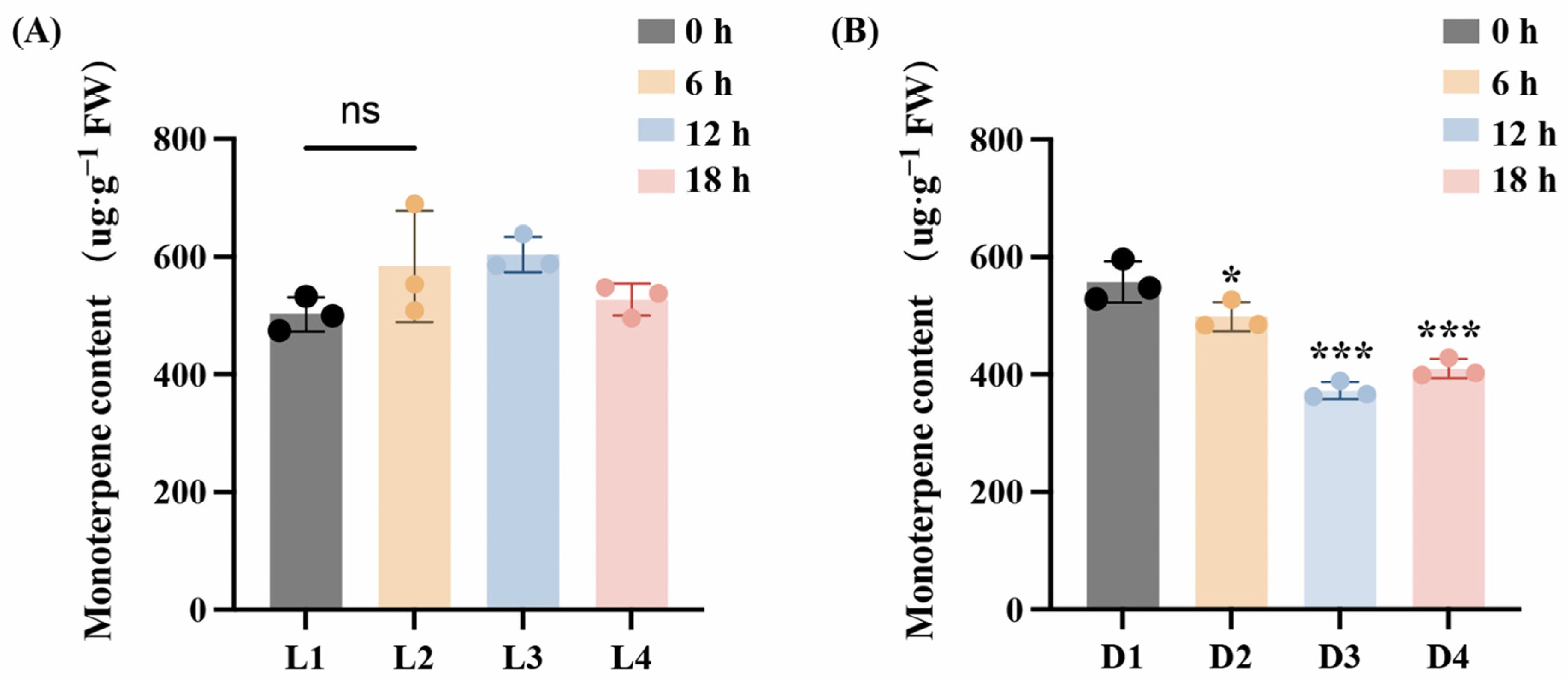
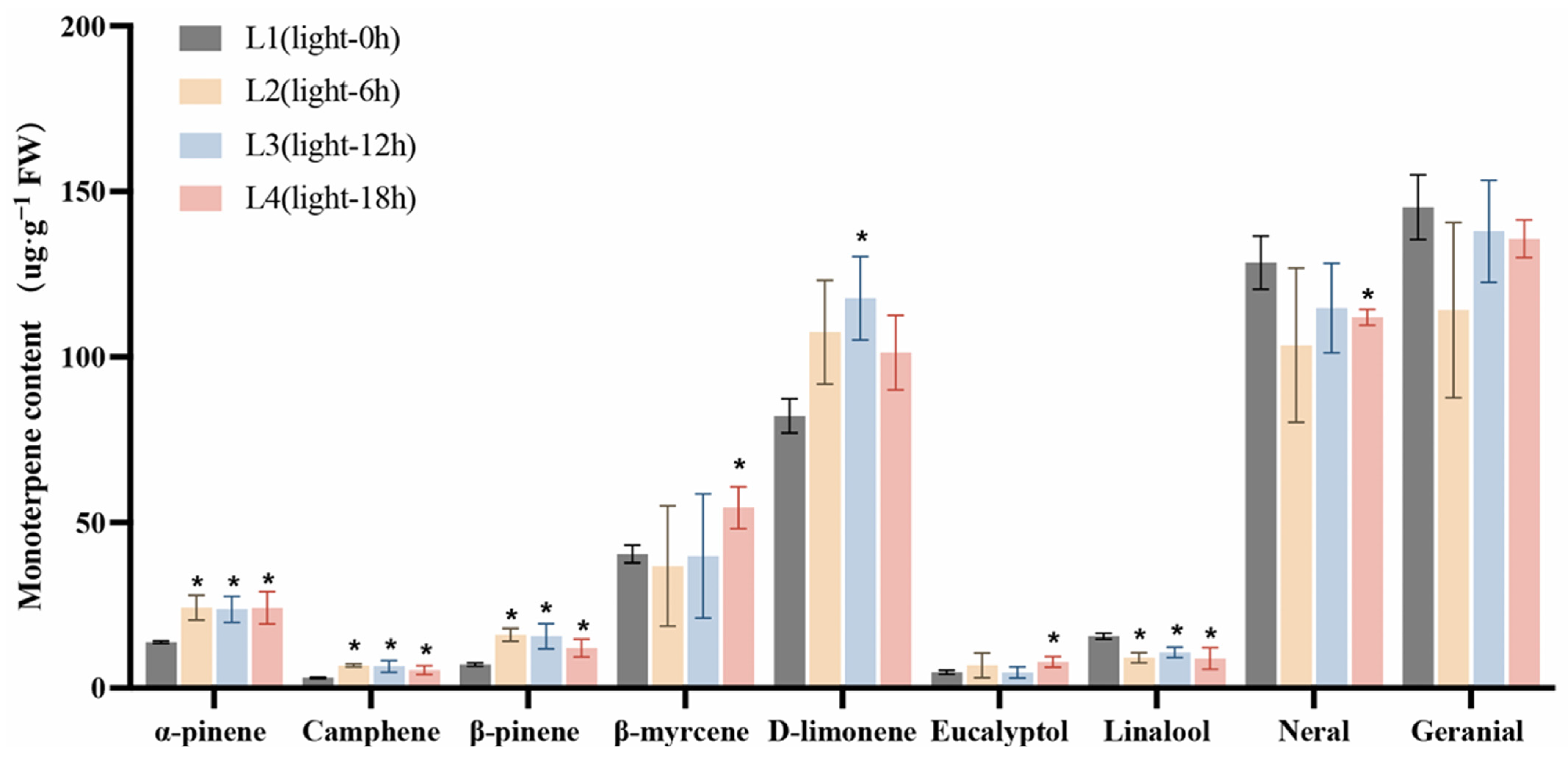
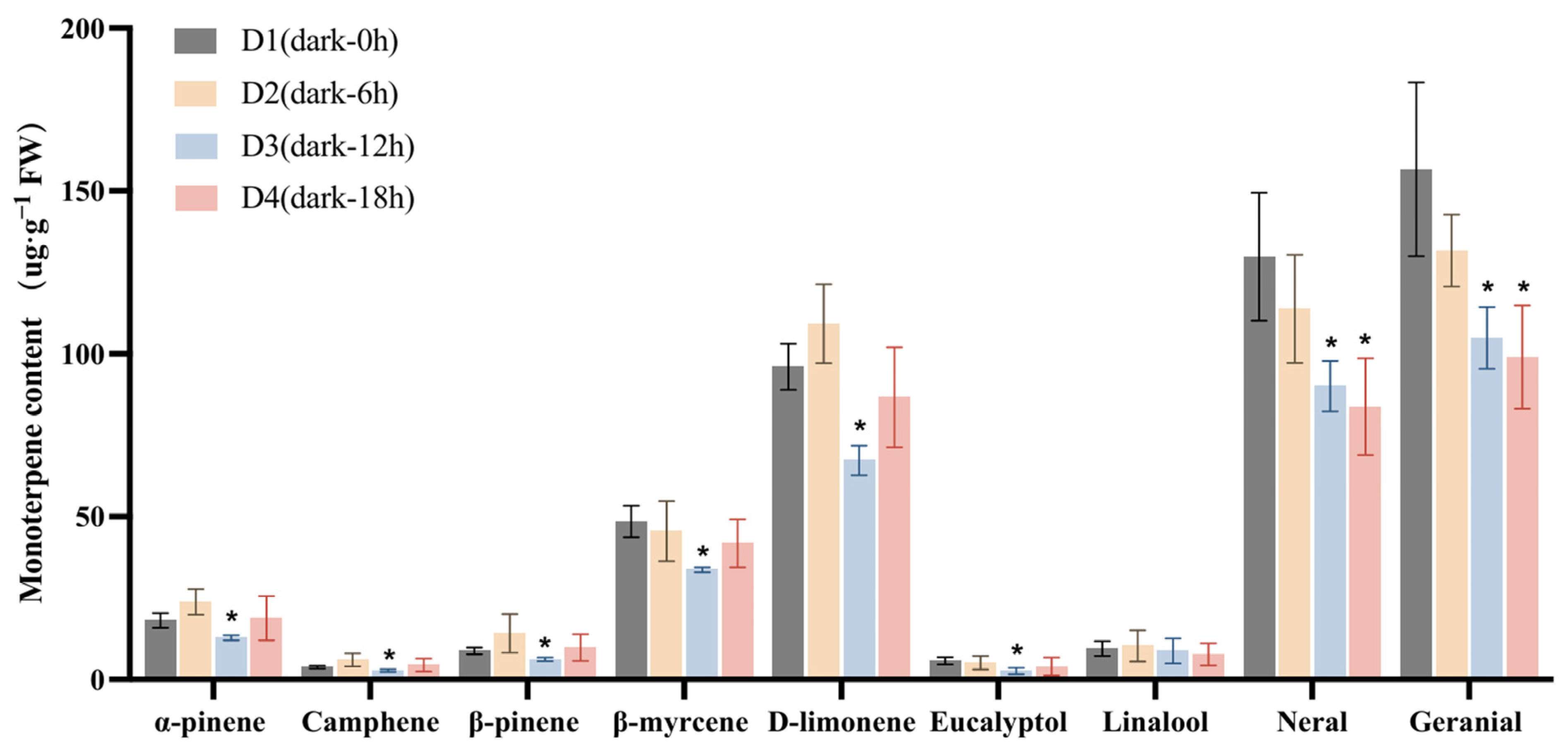
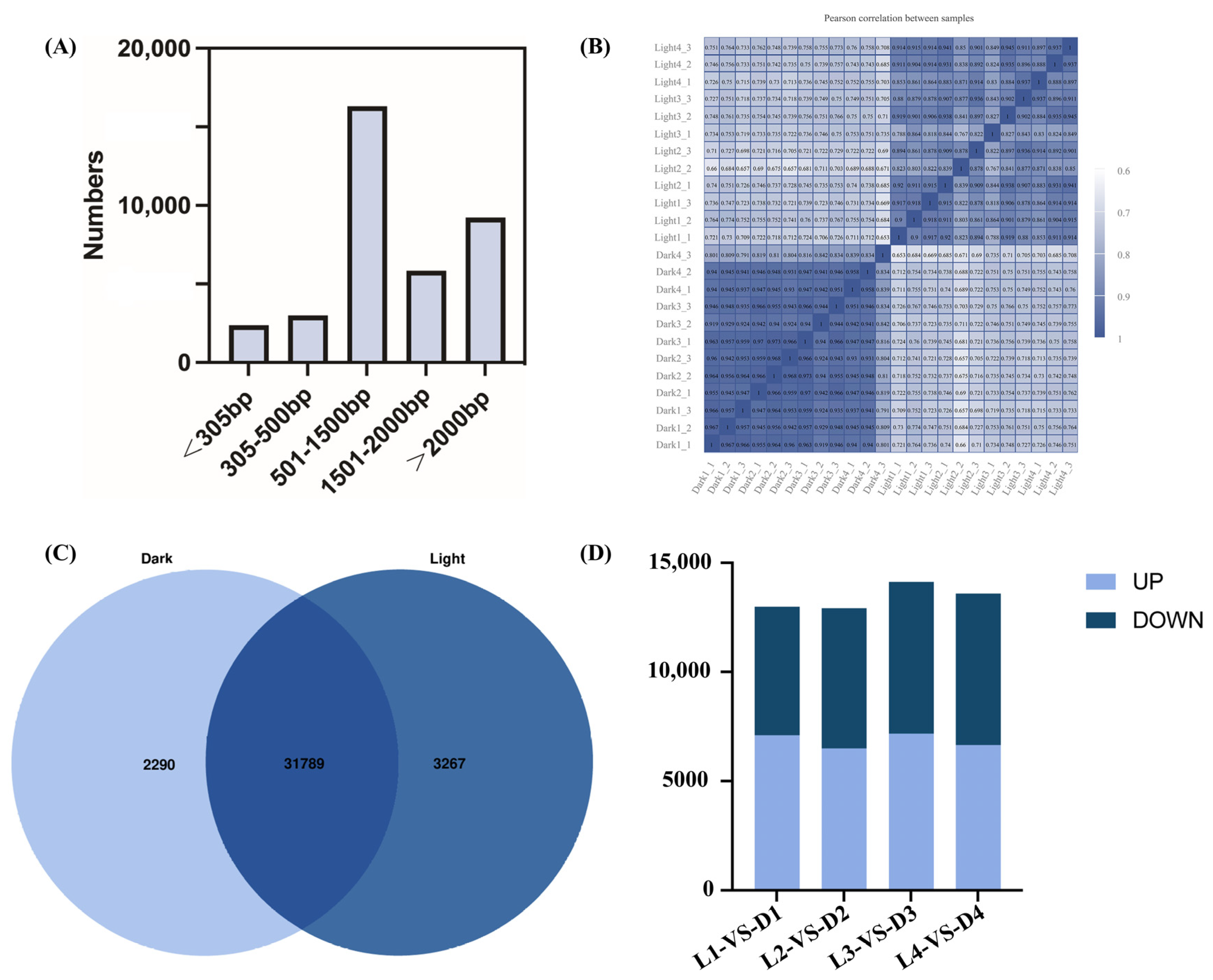
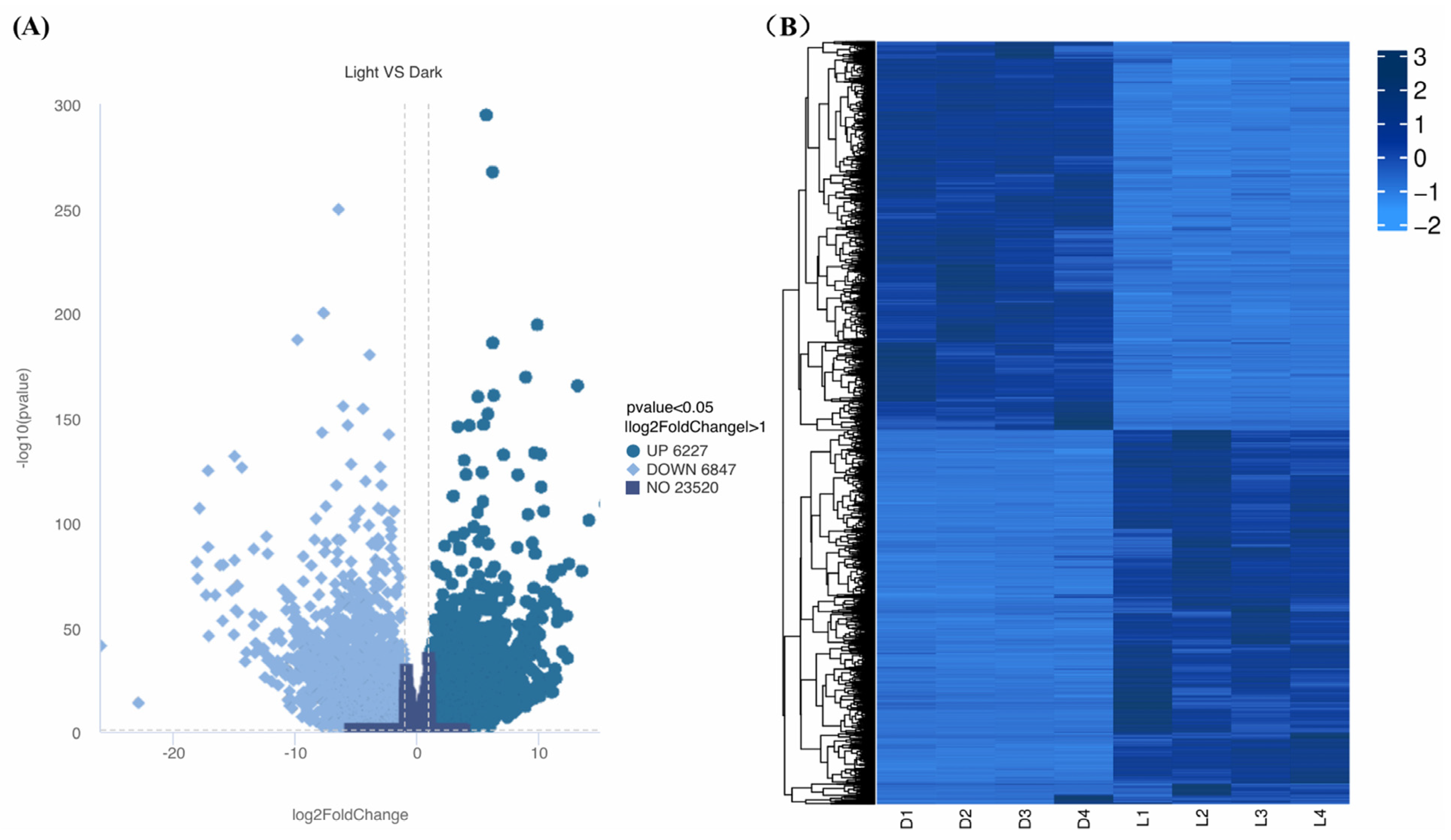

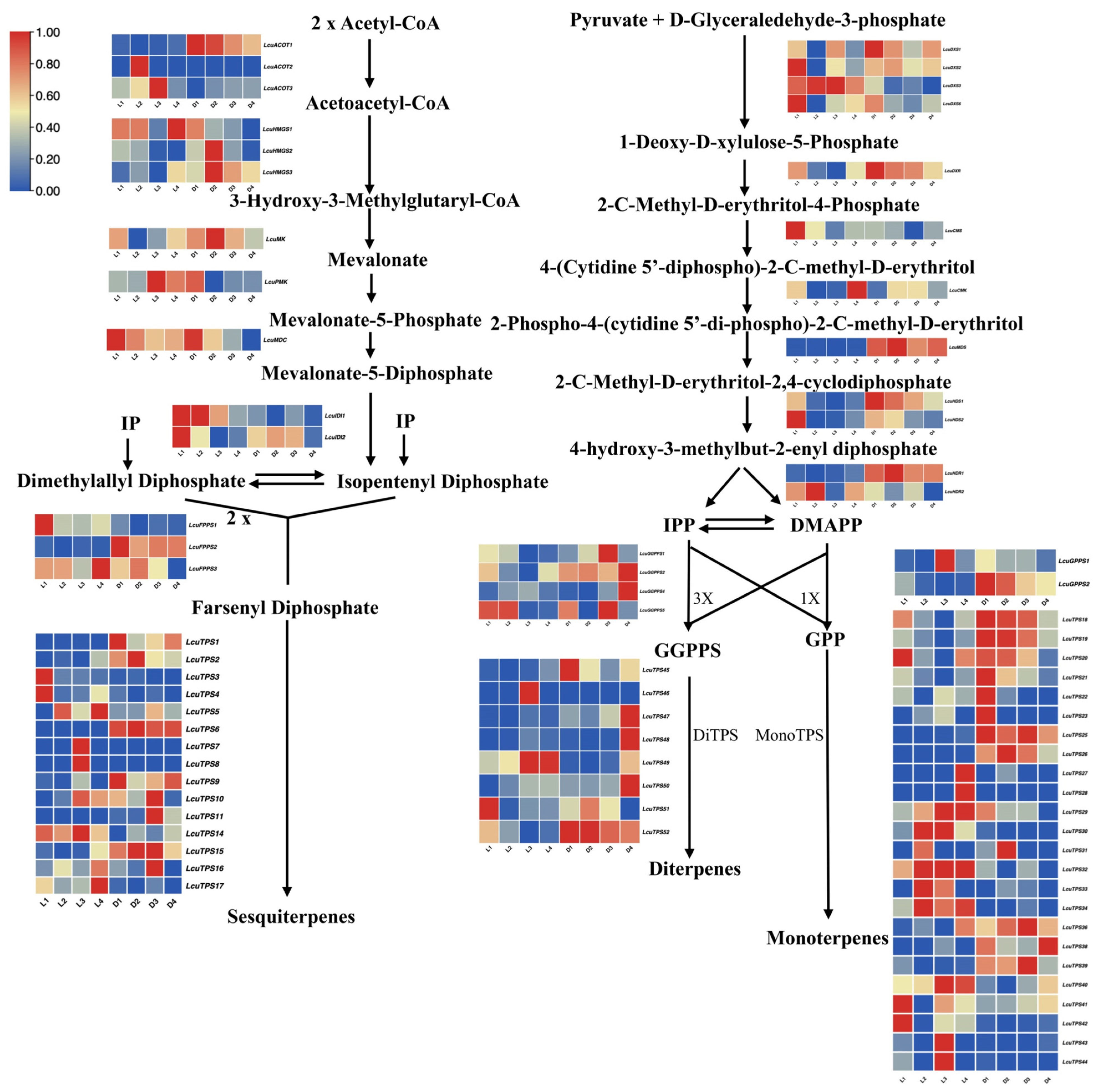
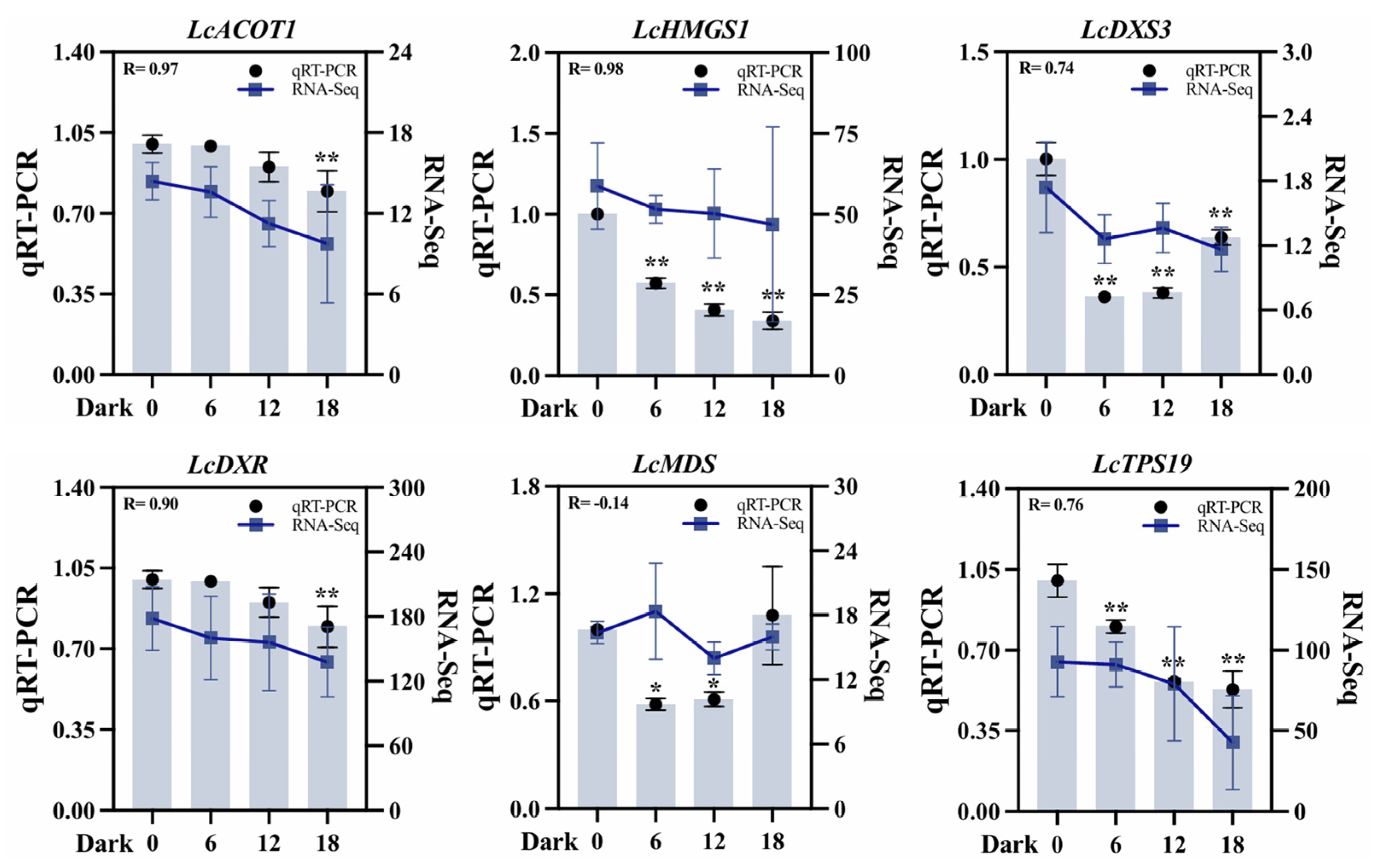
| Treatment | Total Reads | Total Map | Unique Map | Multi Map | Proper Map |
|---|---|---|---|---|---|
| L1 (Light-0 h) | 50,905,702 | 88.78 | 75.63 | 13.14 | 68.22 |
| L2 (Light-6 h) | 47,260,316 | 86.40 | 71.14 | 15.26 | 62.72 |
| L3 (Light-12 h) | 49,269,064 | 86.93 | 71.52 | 15.42 | 62.60 |
| L4 (Light-18 h) | 49,721,182 | 86.28 | 73.65 | 12.64 | 64.60 |
| D1 (Dark-0 h) | 46,314,858 | 87.58 | 79.38 | 8.20 | 71.16 |
| D2 (Dark-6 h) | 48,571,858 | 89.14 | 80.91 | 8.23 | 72.70 |
| D3 (Dark-12 h) | 48,092,412 | 88.91 | 80.59 | 8.32 | 72.77 |
| D4 (Dark-18 h) | 55,470,416 | 88.69 | 80.6 | 8.08 | 71.98 |
| Treatment | Raw_Bases | Clean_Reads | Q20 | Q30 | GC_pct |
|---|---|---|---|---|---|
| L1 (Light-0 h) | 7.18 G | 44,639,390 | 98.85 | 96.9 | 46.9 |
| L2 (Light-6 h) | 7.57 G | 47,260,316 | 98.79 | 96.82 | 46.48 |
| L3 (Light-12 h) | 6.99 G | 42,747,128 | 98.91 | 97.03 | 45.56 |
| L4 (Light-18 h) | 7.45 G | 46,877,574 | 98.78 | 96.7 | 46.6 |
| D1 (Dark-0 h) | 7.36 G | 45,436,082 | 98.85 | 96.91 | 45.46 |
| D2 (Dark-6 h) | 7.62 G | 48,571,858 | 98.87 | 96.94 | 46.1 |
| D3 (Dark-12 h) | 6.66 G | 42,364,516 | 98.8 | 96.75 | 46.25 |
| D4 (Dark-18 h) | 8.97 G | 55,470,416 | 98.84 | 96.83 | 45.95 |
Disclaimer/Publisher’s Note: The statements, opinions and data contained in all publications are solely those of the individual author(s) and contributor(s) and not of MDPI and/or the editor(s). MDPI and/or the editor(s) disclaim responsibility for any injury to people or property resulting from any ideas, methods, instructions or products referred to in the content. |
© 2025 by the authors. Licensee MDPI, Basel, Switzerland. This article is an open access article distributed under the terms and conditions of the Creative Commons Attribution (CC BY) license (https://creativecommons.org/licenses/by/4.0/).
Share and Cite
Yang, J.; Zhao, Y.; Chen, Y.; Wang, Y.; Gao, M. A Comprehensive Analysis of Transcriptomics and Metabolomics Reveals Key Genes Involved in Terpenes Biosynthesis Pathway of Litsea cubeba Under Light and Darkness Treatments. Int. J. Mol. Sci. 2025, 26, 2992. https://doi.org/10.3390/ijms26072992
Yang J, Zhao Y, Chen Y, Wang Y, Gao M. A Comprehensive Analysis of Transcriptomics and Metabolomics Reveals Key Genes Involved in Terpenes Biosynthesis Pathway of Litsea cubeba Under Light and Darkness Treatments. International Journal of Molecular Sciences. 2025; 26(7):2992. https://doi.org/10.3390/ijms26072992
Chicago/Turabian StyleYang, Jiahui, Yunxiao Zhao, Yicun Chen, Yangdong Wang, and Ming Gao. 2025. "A Comprehensive Analysis of Transcriptomics and Metabolomics Reveals Key Genes Involved in Terpenes Biosynthesis Pathway of Litsea cubeba Under Light and Darkness Treatments" International Journal of Molecular Sciences 26, no. 7: 2992. https://doi.org/10.3390/ijms26072992
APA StyleYang, J., Zhao, Y., Chen, Y., Wang, Y., & Gao, M. (2025). A Comprehensive Analysis of Transcriptomics and Metabolomics Reveals Key Genes Involved in Terpenes Biosynthesis Pathway of Litsea cubeba Under Light and Darkness Treatments. International Journal of Molecular Sciences, 26(7), 2992. https://doi.org/10.3390/ijms26072992







